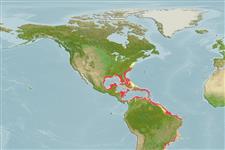>
Mulliformes (Goatfishes) >
Mullidae (Goatfishes)
Etymology: Pseudupeneus: Greek, pseudes = false + Peneus, the name of a river.
More on author: Bloch.
Environment: milieu / climate zone / depth range / distribution range
Οικολογία
Θαλασσινό(ά) Υφαλόφιλο(α); εύρος βάθους 0 - 90 m (Ref. 9626), usually 0 - 35 m (Ref. 40849). Subtropical; 40°N - 30°S, 98°W - 28°W
Western Atlantic: Bermuda and New Jersey, USA to Santa Catarina, Brazil (Ref. 57756), including the Gulf of Mexico and throughout the Caribbean Sea (Ref. 9626).
Length at first maturity / Μέγεθος / Βάρος / Age
Maturity: Lm 18.0 range ? - ? cm
Max length : 30.0 cm TL αρσενικό/απροσδιόριστο; (Ref. 7251); common length : 22.0 cm TL αρσενικό/απροσδιόριστο; (Ref. 3792)
Ραχιαίες άκανθες (συνολικά): 8 - 9; Μαλακές ραχιαίες ακτίνες (συνολικά): 8. A series of three large blackish blotches on upper side of body beneath dorsal fins; color variable but usually pale, the scales of the back with reddish or yellowish brown edges and a central pale blue spot; diagonal light blue lines on head. Capable of displaying a pattern of large red blotches on head and body in less than a minute (Ref. 13442).
Inhabits shallow waters to depths of 90 m (Ref. 9626), especially over sand and rock bottoms in reef areas. Young juveniles often found on beds of seagrass, e.g. Thalassia. Feeds on small invertebrates (Ref. 9626). Flesh highly esteemed; marketed fresh and frozen (Ref. 3792). Traded as an aquarium fish at Ceará, Brazil (Ref. 49392).
Spawnng may either be in pairs or in small groups (Ref. 240).
Cervigón, F., 1993. Los peces marinos de Venezuela. Volume 2. Fundación Científica Los Roques, Caracas,Venezuela. 497 p. (Ref. 9626)
IUCN Red List Status (Ref. 130435)
Threat to humans
Reports of ciguatera poisoning (Ref. 30303)
Human uses
Warning: mysqli::__construct(): (08004/1040): Too many connections in /var/www/html/includes/func_getlabel.php on line 46
Can't connect to MySQL database (fbapp). Errorcode: Too many connections
